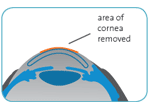PRK (Photoreactive Keratectomy) Laser Eye Surgery
PRK (photoreactive keratectomy) is a procedure in which a laser is used to reshape corneal tissue. PRK eye surgery can be used to treat low-to-moderate nearsightedness, farsightedness and astigmatism. Sansum Clinic’s laser eye surgeon uses a computer-guided excimer laser to reshape the cornea.
PRK Diagram of Laser Beam
 Your surgeon uses a computer-guided excimer laser to reshape the cornea.
Your surgeon uses a computer-guided excimer laser to reshape the cornea.
PRK Diagram of Area of Cornea Removed
 After laser treatment, you will wear a contact lens as a bandage for a few days. This protects the cornea as it heals.
After laser treatment, you will wear a contact lens as a bandage for a few days. This protects the cornea as it heals.
What to Expect with PRK Surgery
Before your PRK eye surgery, you may be given medication to help you relax. Eye drops numb your eyes. A device is used to keep your eyes open. A small surgical tool or the laser is first used to remove the epithelium (outer layer of your cornea). Laser treatment lasts for 10 to 90 seconds. For a few days after the procedure, your vision may seem worse—but should begin to improve in about five days and stabilize in about six months.
What You Should Consider
Pros:
- No risk of flap complications
- Better for patients with thin corneas, previous glaucoma surgery, mild corneal scars or other cornea problems
Cons:
- Mild-to-moderate pain after surgery
- Longer vision recovery than LASIK
- May need to use eye drops for three months or longer
Risk of:
- Corneal scarring or haze
- Temporary or permanent dry eye
- Night vision problems, such as halos, glare or starbursts
- Under or overcorrection
- Loss of best corrected vision
Are you ready for laser eye surgery? Find out
what you need to know about laser eye surgery at the Laser Eye Care Center.
Schedule Your Laser Eye Surgery Consultation Today
Contact the Laser Eye Care Center and let us help you reclaim a life free of glasses or contacts.